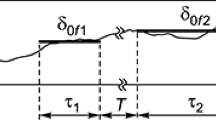Conclusions
-
1
It is possible to measure frequencies whose values are or are not multiples of the reference frequency by obtaining in a comparison method a difference frequency which can either be measured directly or used for sequential separation of difference frequencies down to a value which can be measured with the required precision.High measurement precision is obtained by separating the difference frequencies between the harmonics of the measured frequencies (including their differences) and either the fundamental, harmonics or subharmonics of the reference frequency.
-
2
Expressions (11) and (13) obtained above for calculating the measured frequency error and the random error of comparison for any ratios between the tested and reference frequencies have the same form as expressions (4) and (6) obtained for testing only multiple frequencies.
-
3
It has been shown that the total short-duration instability (nonmonochromaticity) of the tested and reference frequencies, and the random errors due to phase instability in the course of transmission, propagation and reception of reference frequencies, and in the course of the conversion of tested and reference frequencies and the separation of difference frequencies can limit the precision of comparison irrespective of the smallness of the measuring method error.
-
4
The measuring method errors referred to the measured frequency level, namely, the systematic error Βa and the random error\(\Delta \bar \beta _a \) are determined by the errors which arise in each conversion and separation of difference frequencies, and by the value of the conversion factor.
In order to obtain a small measuring method error it is necessary to make the product of k1...kn sufficiently large for the smallest possible number of conversions. The largest measurement error is produced by the first separation of the difference frequency if β1≈β2≈...≈βn,\(\Delta \bar \beta _1 \) ≈\(\Delta \bar \beta _2 \) ≈... ≈\(\Delta \bar \beta _n \) and k1≈k2≈...kn≫1.
Similar content being viewed by others
Literature cited
V. F. Lubentsov, Izmerit. tekh., No. 6 (1960).
M. F. Malikov, Foundations of Metrology [in Russian]. M., (1949).
E. V. Artem'eva and V. F. Lubentsov, Instruction No. 215-54. USSR Ministry of Finances, M., (1956).
E. V. Artem'eva and V. F. Lubentsov, Izmerit. tekh., No. 2 (1958).
B. M. Shchigolev, Mathematical Treatment of Observations [in Russian]. M., (1962).
WWV and WWVH Standard Frequency and Time Transmissions. Proc. IRE, No. 8 (1962).
Rights and permissions
About this article
Cite this article
Lubentsov, V.F. Precision in measuring frequency by means of reference frequencies. Meas Tech 7, 1075–1080 (1964). https://doi.org/10.1007/BF00983170
Issue Date:
DOI: https://doi.org/10.1007/BF00983170




